Introduction to E-commerce Website Design and Its Importance

In today’s world, where businesses are rapidly digitizing, having an efficient e-commerce website is no longer an option, but an undeniable necessity.
#ECommerceWebsiteDesign allows you to offer your products and services to potential customers beyond geographical limitations and significantly expand your target market.
Have you ever wondered how you can increase your income without needing a physical store? The answer lies in e-commerce website design.
This process is not limited to just building a website; it includes optimizing user experience, securing payments, and creating a platform for effective customer communication.
The importance of these types of websites stems from the fact that today’s customers prefer to make their purchases online, anytime and anywhere.
A successful online store can act as a 24/7 branch for your business, without the need to pay rent, hire in-person sales staff, or worry about business hours.
In fact, investing in e-commerce website design is an investment in the future of your business, and its long-term return will be very significant.
This approach not only increases your sales but also greatly helps strengthen your brand in the digital space.
The question is, is your business ready to leap into this new and opportunity-filled world?
Tired of losing customers due to poor e-commerce website design? Solve this problem forever with Rasawweb!
✅ Increase sales and conversion rates from visitors to customers
✅ Smooth and attractive user experience for your customers⚡ Get a free consultation
Initial Steps Before Starting E-commerce Website Design

Before you start designing your e-commerce website, you need to have a precise and comprehensive plan.
This stage is as important as the design process itself and can determine the success or failure of your project.
First, you need to fully identify your products or services and decide what you are going to sell.
Are you targeting a specific niche market or do you want to offer a variety of products? Identifying your target audience is also a very important step.
What are the age, gender, interests, income level, and needs of your customers? This information helps you tailor your design, content, and marketing strategy to have the greatest impact.
Also, you need to identify and analyze your competitors.
What are their strengths and weaknesses? How can you differentiate yourself from them and create a competitive advantage? A comprehensive competitive analysis provides valuable insights.
Budgeting is also a critical step.
How much do you want to spend on building and maintaining your e-commerce website? This budget should include design costs, hosting, domain, plugins, marketing, and support.
Finally, you need to have an initial content plan; what types of pages do you need (homepage, products, about us, contact us, blog) and what information should be on them.
These steps are essential for anyone planning to launch and develop an e-commerce website, and without them, the probability of success significantly decreases.
Remember, a strong foundation is the key to building a stable structure.
Choosing the Right Platform for Your Online Store
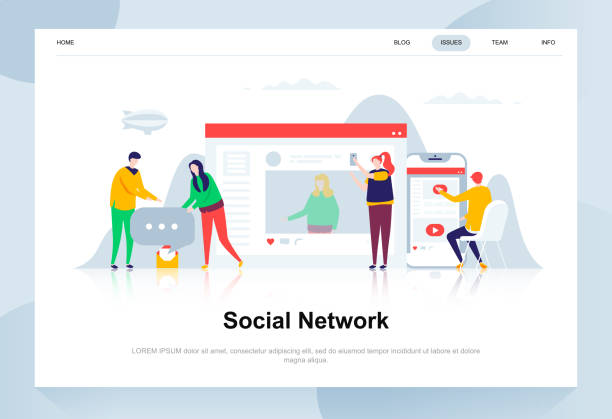
One of the most important decisions you need to make on the path to designing your e-commerce website is choosing the right platform.
This choice directly impacts your scalability, security, customization capabilities, and long-term costs.
Various platforms are available in the market, each with its own features and advantages.
For example, WooCommerce, a powerful plugin for WordPress, is a popular option for small and medium-sized businesses.
This platform offers high flexibility and, with a large number of themes and plugins, provides extensive customization possibilities.
On the other hand, Shopify is a SaaS (Software as a Service) platform that is more suitable for beginners and requires less technical knowledge, but has some limitations in terms of customization.
Magento is also a powerful open-source platform suitable for large and complex stores with specific needs, but it requires higher technical expertise.
The choice of platform should be made based on your budget, technical knowledge, product volume, and long-term goals.
Before making a final decision, be sure to review the capabilities of each platform and ensure that it covers the current and future needs of your business.
This decision will have a direct impact on the performance of your e-commerce website and should not be underestimated.
An inappropriate platform can lead to additional costs and technical problems in the future.
The table below provides a comparison of several popular platforms.
| Platform | Suitable for | Advantages | Disadvantages |
|---|---|---|---|
| WooCommerce | Small and medium-sized businesses | High flexibility, numerous plugins, large community | Requires hosting and basic technical knowledge, user responsible for security |
| Shopify | Beginner users, fast-growing businesses | Easy to use, excellent support, high security | Limited customization, monthly fees, transaction fees |
| Magento | Large and complex stores | Powerful, high scalability, extensive features | Requires high technical expertise, high development and maintenance costs |
Key Elements in E-commerce Website User Experience (UX) Design
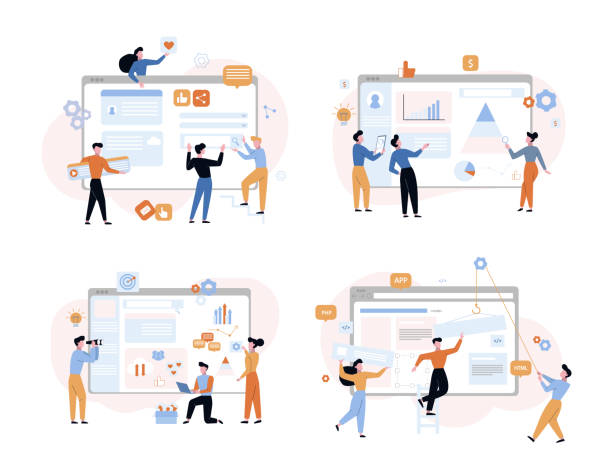
User Experience (UX) is the heart of any successful e-commerce website design.
Great UX means that customers can easily find the products they want, complete their purchases without hassle, and enjoy the overall online shopping process.
The first key element is easy and intuitive navigation.
Clear menus, logical categories, and powerful search capabilities help users quickly access what they want.
Responsive Design is also crucial; your site should display correctly and provide a consistent user experience across all devices, from desktop computers to tablets and mobile phones.
Site loading speed is also a determining factor; studies have shown that users expect sites to load in less than 3 seconds, otherwise, many of them abandon the site.
High-quality images and detailed product descriptions also play a significant role in customer decision-making.
Images should be presented from different angles, with full details, and zoom capability.
The payment process should be simple and straightforward; minimize the number of shopping cart steps and offer various payment options.
Customer reviews and ratings also increase your site’s credibility and reassure new buyers.
Finally, customer support via online chat, phone, or email strengthens trust and loyalty among customers.
By considering these elements in your e-commerce website design, you can significantly increase your conversion rate and turn customers into loyal buyers.
An online store design that pays attention to UX details will always be one step ahead of the competition.
Does your current website convert visitors into customers or drive them away? Solve this problem forever with professional corporate website design by Rasawweb!
✅ Build a powerful and reliable brand image
✅ Attract target customers and increase sales
⚡ Get a free consultation now!
The Importance of SEO and Content Optimization in E-commerce Website Design
![]()
Regardless of how beautiful and functional your e-commerce website design is, if customers cannot find it, your efforts will be futile.
This is where Search Engine Optimization (SEO) and content strategy become important.
SEO is the process of improving your site’s ranking in Google search results and other search engines, which leads to an increase in organic (free) traffic.
For an online store, optimizing for keywords related to your products and services is crucial.
This includes keyword research, using them in page titles, product descriptions, image alt texts, and even URLs.
Producing high-quality and unique content for each product and category page not only helps with SEO but also provides customers with enough information to make a decision.
Additionally, launching a blog related to your business field can greatly help the SEO of your e-commerce site.
Educational articles, buying guides, industry news, and product reviews can attract a lot of traffic to your site and increase your credibility as a reliable source of information.
Technical SEO (such as loading speed, URL structure, sitemap, and robots.txt file) is also of high importance and should be carefully observed by site designers.
Proper internal links between different pages of the site also help search engines better understand your site’s structure and determine the importance of different pages.
Mobile optimization (Mobile-first indexing) is another important SEO factor that Google highly values.
Finally, content marketing and SEO should be considered an integral part of the e-commerce website design process so that your site is ready for success in online searches from the very beginning.
Security and Payment Gateways in Online Stores
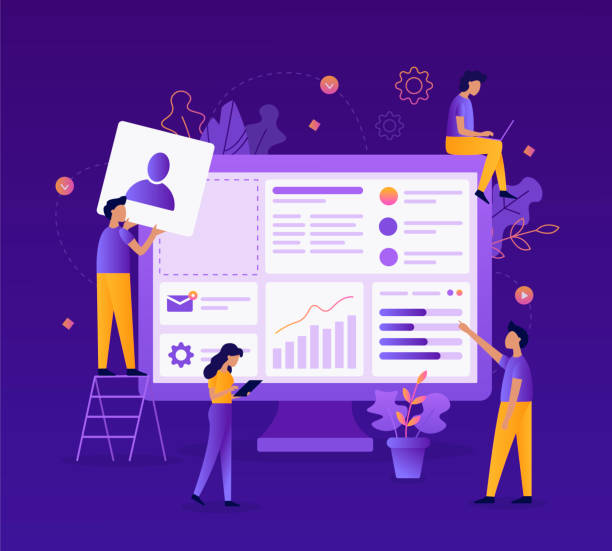
Security is one of the most important pillars of e-commerce website design that builds customer trust and protects their sensitive data.
Without strong security, there is a risk of losing customers, damaging brand reputation, and even facing legal issues.
The first step in ensuring security is to use an SSL certificate (Secure Sockets Layer).
This certificate encrypts the information exchanged between the user and the server and prevents eavesdropping.
The presence of a green lock icon next to the site address and the HTTPS protocol indicates site security.
Payment gateways also play a vital role in the financial security of transactions.
You should use reputable and well-known payment gateways that comply with high security standards (such as PCI DSS).
These gateways are responsible for securely processing credit card information, and you as the store owner do not need to store this information.
Also, regular updates of the e-commerce platform (such as WordPress and WooCommerce) and all plugins and themes are very important for fixing security vulnerabilities.
Using Web Application Firewalls (WAF), protection against DDoS attacks, and regular data backups are other essential security measures.
Educating employees about the importance of cybersecurity and identifying phishing can also help prevent security breaches.
Ensuring that the payment process on your site is not only secure but also simple and transparent will increase conversion rates and reduce abandoned shopping carts.
An online store that prioritizes security not only protects itself but also earns customer trust for repeat purchases.
Marketing and Targeted Traffic After Launching the E-commerce Website

After completing the e-commerce website design and launching it, the main work has just begun: attracting targeted traffic and converting it into customers.
Without a strong marketing strategy, even the best online store will go unnoticed.
One of the most effective methods is content marketing, which was mentioned earlier; creating valuable and engaging content on the blog can guide users to your site.
Social media marketing is also a powerful tool for increasing brand awareness and attracting new customers.
An active presence on platforms such as Instagram, Telegram, and Twitter, publishing engaging visual content, and interacting with the audience can send significant traffic to your online store.
Email marketing campaigns are also very effective for maintaining communication with current customers and re-engaging lost customers; sending newsletters, special offers, and notifications about new products increases customer loyalty.
Paid ads such as Google Ads and social media advertising can quickly attract targeted traffic to your site, although they require a budget.
Collaborating with influencers and affiliate marketing are also effective ways to expand your reach.
Analyzing data and user behavior using tools like Google Analytics helps you measure the performance of your marketing campaigns and optimize your strategies.
This is a continuous cycle of analysis, optimization, and execution that contributes to the sustainable growth of your e-commerce website.
The table below compares some marketing methods.
| Marketing Method | Advantages | Disadvantages | Traffic Impact |
|---|---|---|---|
| Content Marketing | Increased SEO, building credibility, organic attraction | Time-consuming results, need for continuous content production | Long-term and sustainable |
| Social Media Marketing | Direct interaction with the audience, brand awareness expansion, virality | Need for active and continuous presence, algorithm changes | Fast and extensive |
| Paid Ads | Fast results, precise targeting, budget control | Requires budget, high competition, traffic stops with budget cut | Immediate and controlled |
Support, Updates, and Maintenance of E-commerce Websites
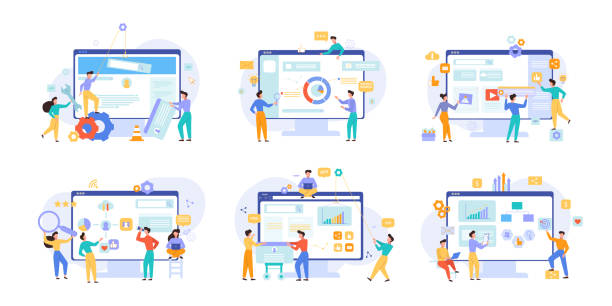
After launching and even after successfully designing your e-commerce website and marketing it, your work is not over.
An online store requires continuous care and maintenance to remain up-to-date, secure, and efficient.
Customer support is one of the vital aspects.
Providing diverse methods for contacting support (such as online chat, phone, email, and FAQ section) and responding quickly and effectively to customer questions and problems greatly increases their loyalty.
After-sales support is as important as pre-purchase support.
Also, regular updates of the platform, themes, and plugins are essential for maintaining security, fixing bugs, and benefiting from new features.
Neglecting these updates can expose your site to security attacks or lead to its malfunction.
Technical site maintenance includes checking broken links, database optimization, cache clearing, and server performance monitoring.
Regular backups of all site data (products, orders, customer information, etc.) are also of high importance so that in case of any serious problem, you can quickly restore the site.
Monitoring site performance, loading speed, and server health helps you identify and resolve potential issues before they become serious.
This continuous process of maintenance and optimization ensures that your e-commerce website is always at its peak performance and provides a positive user experience for customers.
Investing in professional support and maintenance services for your online store is a smart decision that prevents major problems in the future.
Are you tired of losing business opportunities due to not having a professional corporate website?
Rasawweb helps you with professional corporate website design:
✅ Build a powerful and reliable brand image
✅ Convert site visitors into loyal customers
⚡ Get a free consultation now!
Challenges and Opportunities in the World of E-commerce Website Design
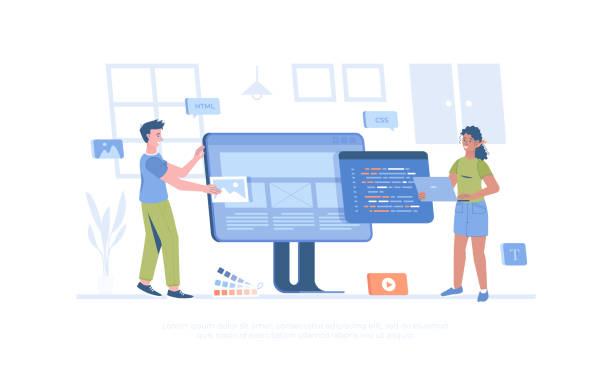
The world of e-commerce website design is rapidly evolving, and we are facing new challenges and opportunities.
One of the biggest challenges is increasing competition.
With more businesses entering the online space, it becomes more difficult to stand out and attract customer attention.
Also, continuous changes in search engine algorithms and new technologies require constant updates and adaptation.
Customer expectations are also increasing; they are looking for personalized shopping experiences, faster delivery, and better customer service.
Security issues and cyber threats also remain a serious challenge.
But alongside these challenges, there are also numerous opportunities.
Using Artificial Intelligence (AI) and machine learning to personalize the shopping experience, suggest relevant products, and improve customer service is one such opportunity.
Augmented Reality (AR) and Virtual Reality (VR) can also revolutionize the shopping experience; they allow customers to virtually try on products at home or view them in 3D before purchasing.
Large online marketplaces like Digikala or Amazon also provide an opportunity for smaller sellers to expose their products to millions of customers.
The emergence of Social Commerce, which enables direct purchasing through social platforms, has also created a new outlook for online stores.
With an innovative approach and focus on providing unique value to customers, these challenges can be overcome, and existing opportunities can be best utilized.
The future of e-commerce website design is full of innovation and new possibilities that can make the online shopping experience even more attractive and easy.
Conclusion and the Future of E-commerce Website Design
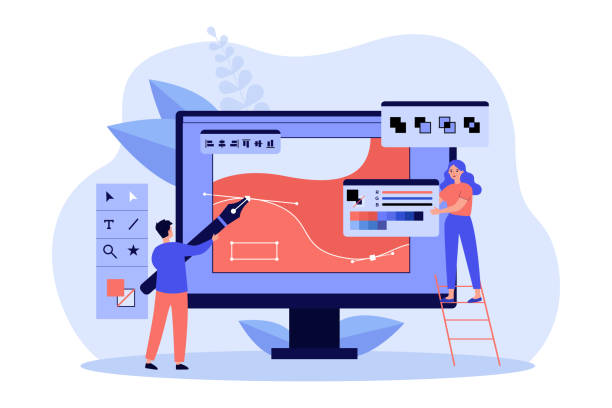
As discussed in this comprehensive article, e-commerce website design goes beyond simply building a website; it is a strategic investment in the future of your business that includes detailed planning, choosing the right platform, optimizing user experience, SEO, ensuring security, marketing strategies, and continuous support.
Each of these steps plays a vital role in the success and sustainability of your online store.
With the increasing growth of e-commerce, the importance of a strong online presence is becoming more apparent than ever.
The future of e-commerce website design will be accompanied by exciting innovations.
We expect to see increased use of Artificial Intelligence for deeper personalization, expansion of interactive shopping experiences using AR/VR, and greater integration with social media platforms.
Also, sustainability and corporate social responsibility in site design and sales processes will become more important.
Future online stores will not only be places for buying and selling goods but also spaces for community building, interaction, and providing unique experiences.
For businesses, this means a continuous need for learning, adaptation, and innovation.
By following the principles and guidelines presented in this article, you can create a professional and successful e-commerce website that not only meets today’s needs but is also prepared for future challenges and opportunities.
Remember that success in the digital world is a journey, not a fixed destination, and your e-commerce website design is just the starting point of this exciting journey.
Frequently Asked Questions
| Question | Answer |
|---|---|
| What is e-commerce website design? | The process of creating an online platform for selling products or services, which includes designing the user interface (UI), user experience (UX), and necessary functionalities for online shopping. |
| What are the key features of a good e-commerce website? | Easy navigation, high loading speed, strong search capability, efficient shopping cart, secure payment gateway, clear product display with high-quality images, user review display capability, and responsiveness (mobile compatibility). |
| What platforms are common for e-commerce website design? | Popular platforms such as WooCommerce (on WordPress), Shopify, Magento, PrestaShop, and also custom content management systems. |
| What is the importance of an e-commerce website being responsive? | Given the increasing use of mobile for online shopping, a responsive website (correct display on different screen sizes) is crucial for providing a good user experience and increasing conversion rates. |
| How long does the process of designing an e-commerce website usually take? | The duration depends on the project’s complexity, the number of products, special features required, and the implementation method, and can vary from a few weeks to several months. |
And other services of Rasawweb Advertising Agency in the field of advertising
Smart Google Ads: A new service to improve SEO ranking through precise audience targeting.
Smart Custom Software: A creative platform to improve digital branding with attractive UI design.
Smart Customer Journey Map: A fast and efficient solution to improve SEO ranking by focusing on Google ad management.
Smart Customer Journey Map: A new service to improve SEO ranking through user experience customization.
Smart SEO: A new service to increase digital branding through user experience customization.
And more than hundreds of other services in the field of internet advertising, advertising consultation, and organizational solutions
Internet Advertising | Advertising Strategy | Advertorials
Resources
Professional E-commerce Website Design Guide on DigikalaBuilding an Online Store from ScratchComplete Guide to E-commerce Website DesignImportant Tips in E-commerce Website Design
? To boost your business in the digital world, partner with Rasawweb Afarin; where expertise, innovation, and smart strategies pave your path to success.
From multilingual website design and SEO to targeted advertising campaigns, Rasawweb Afarin keeps your brand at the top with a comprehensive approach. Contact us today and shape the digital future of your business.
📍 Tehran, Mirdamad Street, next to Bank Markazi, Kazerun Jonubi Alley, Ramin Alley, No. 6


